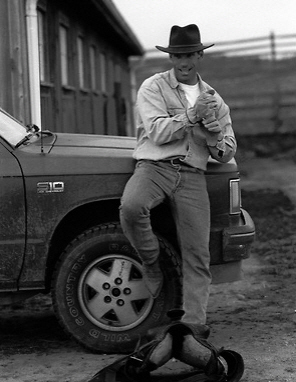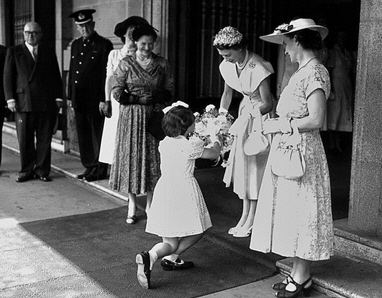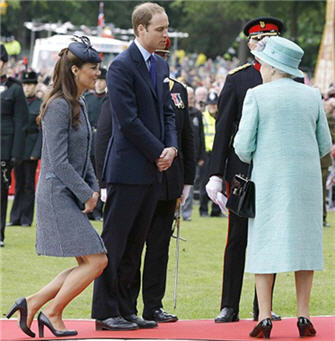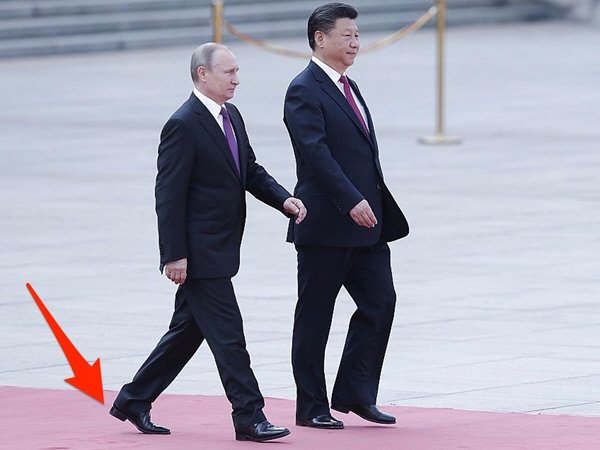Westside Toastmasters is located in Los Angeles and Santa Monica, California
Chapter 16
OWNERSHIP ZONES AND HEIGHT PERCEPTIONS

We stake a physical claim on what we believe is ours
We lean against other people or objects to show a territorial claim to that person or object. Leaning against something can also be used as a method of dominance or intimidation if the object being leaned on belongs to someone else. For example, if you are going to take a photograph of a friend and his new car, boat or personal belonging, it's likely that he'd lean against his new possession, put his foot on it or place his arm around it. When he touches the property, it becomes an extension of his body and this is how he shows others that it belongs to him. Lovers hold hands or put their arms around each other in public to show competitors they have a claim over that person. The business executive puts his feet on his desk or leans against his office doorway to show his claim to that office and its furnishings. A woman dusts imaginary pieces of lint from the shoulder of her husband to tell other women he's taken.

Football quarterback Tom Brady and Gisele BŁndchen
An easy way to intimidate someone is to lean against, sit on or use their possessions without their permission. In addition to the obvious abuse of another's territory or possessions, such as sitting at his desk or borrowing his car without asking, there are many other subtle intimidation techniques. One is to lean against the doorway in another person's office or to sit in his chair.
A salesperson calling on a customer at his home should ask, 'Which chair is yours?' before he sits, because sitting in the wrong chair intimidates its owner and puts him offside.
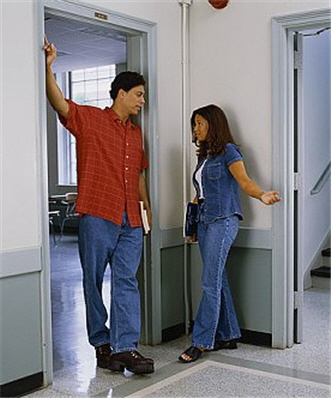
The doorway intimidator
Some people are habitual doorway leaners and go through life intimidating everyone from first introduction. These people are well advised to practice an upright stance with palms visible to create a favorable impression on others. Others form up to 90% of their opinion about us in the first four minutes and you never get a second chance to make a first impression.

Michael Jackson's intent was closing distance between the baby and his fans so they could experience communal 'ownership' of the baby.
If the boss's chair has no arms - which is unlikely as this is usually a feature of the visitor's chair - he may be seen with one or both feet on the desk. If his superior enters the office, it is unlikely that the boss - who is now the subordinate - would continue to use such an obvious territorial/ownership gesture, but instead would resort to more subtle versions such as putting his foot on the bottom drawer of his desk, or, if there are no drawers in the desk, placing his foot hard against the of the desk to stake his claim to it.
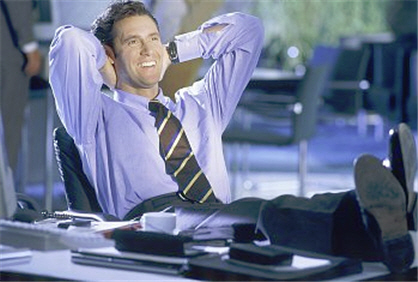
Claiming ownership of the desk
Experimental psychologists in research studies found that participants either viewing or enacting an expansive standing pose leaning over a desk or table with hands spread rated it as an unambiguous power pose. The person leaning in is perceived as the dominant figure in charge of the personal interaction.

Demonstrating who is in charge

Getting in your face, the power lean-in
Body Lowering and Status
Historically, raising or lowering the height of your body in front of another person has been used as a means of establishing superior-subordinate relationships. We refer to a member of royalty as 'Your Highness', whereas individuals who commit unsavory acts are called 'low', 'low down' and 'low lifes'. No one wants to be described as 'short-sighted', be 'looked down on' or 'fall short' of their targets. The protest rally speaker stands on a soapbox to be higher than everyone else, the judge sits higher than the rest of the court, the Olympic gold medal winner stands higher than the other medal winners, those who live in a penthouse command more authority than those who live at ground level, some cultures divide their social classes into the 'upper class' and 'lower class' and pharmacists stand 18 inches above everyone else.
Those envisioning themselves as elevated in social class can sometimes get on their 'high horses', 'rise to the occasion', 'put themselves on a pedestal' or become 'high and mighty'. And no self-respecting God would ever live in the backwoods or in the valley. They live on high in Valhalla or on Mount Olympus. And everyone understands the significance of standing to speak to a meeting to gain control.
Many women in societies steeped in tradition like England will curtsy when they meet royalty and men incline their heads or remove their hats, making themselves appear smaller than the aristocracy. The modern salute is a relic of the act of removing a hat to make oneself appear shorter. The person symbolically goes to remove their hat and the salute is the modern result of what has evolved over time. Today's hatless man can still be seen giving a simple tap to his forehead when he meets a woman as a relic of his ancestors' habit. The more humble or subordinate an individual feels towards another, the lower he stoops his body.
Some Japanese businesses have reintroduced the 'bowing machine', which teaches staff the exact angle to bow to a customer, usually 15 degrees for a customer who is 'just looking' and up to 45 degrees for a purchaser. In business, the people who continually yield, or 'bow' to, company management are labelled with derogatory names such as 'brown-nosers' or 'bootlickers'.
Think Tall
Whether people like to admit it or not, studies
consistently conclude that taller people have
more success, better health, and longer lives than
short people. You look up to a tall person and subconsciously
place him in a protective role.
In addition to their previous studies on the relationship
between height and career success,
University of Florida Professor, Timothy A Judge
and Professor Daniel M Cable of the University
of North Carolina, analyzed data from four independent
projects from the United States and Britain, following approximately 8,500 participants
from their teens through adulthood.
The research findings unambiguously show that tall people have
greater self-esteem and social confidence than
shorter people. The tall person is perceived to be
more authoritative and in command.
The physical action of looking up towards someone
elicits feelings of respect. The person in the
limelight responds with feelings of confidence.
Looking down on another person instills a sense
of superiority on the viewer's part, and submission
on the person being looked at.
There's more to this desire to appear taller than just ego, however. Sociological studies and historical evidence have shown that taller men often enjoy more social success, partly because others tend to have a more positive perception of them.
"We conclude that human height is positively related to interpersonal dominance, and may well contribute to the widely observed positive association between height and social status," write the authors of one peer-reviewed study that was published in 2015 by the University of Groningen in the Netherlands.
At work, shorter women experience less height
bias than men, a phenomenon that may be a
result of evolution - a view offered by Professor
Judge. He suggests that height was an indication
of power in human's early days and that,
even though physical stature and prowess
aren't as relevant today, those evolutionary
appraisals remain. Professor Judge concludes
that, subconsciously, people tend to apply the
power appraisals more to men than to women.
The findings provide evidence that, in the same
way as attractiveness, height, as well as weight
and body image, impacts upon interactions and
salaries.
Living Large
Despite what it may be politically correct to believe about height, studies convincingly show that taller people are more successful, healthier and live longer than short people. Dr Bruce Ellis, Head of Experimental Psychology at the University of Canterbury in New Zealand, found that taller men also have greater reproductive success than shorter men, not only because increased testosterone levels are linked to tallness but also because women choose men who are taller than they are as partners. Taller men are seen as more protective and can pass this advantage on through their genes. Men clearly prefer a woman shorter than they are. The relationship where a woman is taller than the man occurs much less frequently, and according to statistics tends not to endure as long.
It can be readily observed, and has been documented in several studies, how top-level managers are significantly taller than everyone else. In one study the height and salaries of 3000 managers at company director level and found that every inch of height above the company norm added $2,000 to that person's salary package, regardless of whether the person was a man or a woman. Research on Wall Street in the US showed that height is also linked to financial success: every inch of height added $1000 to each person's bottom line. The same correlation has been found in government departments and universities, who supposedly promote people based on their competence level and equality, not their height. One American study showed that tall people not only got the best jobs in American firms, they received higher starting salaries. Those over 6 feet 2 inches (1.9m) got 12% more than those under 6 feet (1.85m).
Not surprisingly, the study showed that the biggest correlation between height and salary was in sales and management, areas in which social interaction is vital for success. If the customer perceives the salesperson as tall and commanding, he follows the salesperson's lead.
Huh, He Seemed Taller on TV?
People who are 'perceived' as tall also do better in politics on video mediums; on-screen people may be only one foot, so we are left subconsciously to decide how tall the person really is. The height we decide they are and the amount of power we give them is directly related to the power and authority of their presentation. This is why so many short actors, politicians and personalities do so well on television - they simply act tall or make physical adjustments to change our perceptions of their height.
A successful politician needs a few things: good ideas, a strong voter base, and above-average height. Apparently, we're not opposed to having political leaders on the tall side.
To understand how perceived height can make a difference, on one occasion two political leaders were invited to participate in two debates about how they would run the country. One candidate was 5 feet 9 inches and was seen by voters as shorter due to his milder, quieter approach, while his competitor was 6 feet 2 inches and perceived by the electorate as even taller due to his assertive, authoritative attitude. After the first TV debate, the shorter candidate was seen as having lost badly to the taller one. The shorter candidate received professional advice on how to change his tactics. One tactic involved cutting 4 inches off his lectern, resulting in the same visible distance between the top of the lectern and his chin as the taller candidate. A second suggestion was for this candidate to arrange for his TV camera to be slightly lowered to shoot upwards, giving him a taller appearance. Yet another tactic was to pitch his message directly to the camera so that each voter felt as if they were being addressed personally.
After the next debate, the shorter candidate was seen as being the outright winner, with the media reported that he 'had a new sense of authority and leadership'. The shorter candidate won the following election. The lessons here were that voters generally aren't deeply interested and don't remember much of what politicians say in election debates. Voters cast their final vote based on the belief that the winner in visible contests is best suited to be the leader.
A recent study shows that our penchant for the more vertically inclined might have an evolutionary basis. The research, published in the journal Social Science Quarterly, shows that the preference could be rooted in our inner ancient caveman - we tend to admire and prefer traits that would've made good leaders back in the hunting-and-gathering days.
For the study, researchers had 500 U.S. university students describe and then sketch out a figure that is representative of a "typical citizen" and an "ideal national leader." Researchers found that 64 percent of the students drew the "ideal national leader" taller than the "typical citizen".
Then, researchers had the students answer questions about their own leadership skills, as well as to consider how height might factor in to attitudes about running for political office. They found that there was a strong association between the student's actual height and their perceived leadership skills, as well as their interest in running for office.
According to The New York Times, the taller of the two major candidates has won the US presidential election twice as often as the shorter candidate. All this time you thought Texas politicians wore cowboy boots just for their folksy charm.
In any competitive environment where opinions and egos clash - as they often do in politics - an inch or two of height is no small advantage. Keeping that in mind, it's understandable that a politician would want to wear boots or other slightly heeled shoes to appear taller.
Politicians from Florida Senator Marco Rubio to Russian President Vladimir Putin have visibly employed the heeled-shoe technique. It's difficult to pin down a man's actual height after all, as there is often a discrepancy between the official statement of a leader's height and how tall they stand in real life.
Our impressions of a person's height are fed by a professional or formal title associated with them too. Pioneering research by Wilson (1968) found that when a student addressed other students, he would be seen as 5 feet 9 inches tall by the other students. When the same student was introduced as a professor, the audience perceived him as 6 feet 3 inches tall. A powerful performance or an impressive title both lead to you being perceived as taller.
Toooo Tall
Being tall, however, is not always a bonus. While tall people often command more respect than short people, height can also be detrimental to some aspects of one-to-one communication, for instance where you need to 'talk on the same level' or have an 'eye-to-eye' discussion with another person and do not want be perceived as 'too big for your shoes'.
In Britain, Philip Heinicy, a 6 feet 8 inches (2m) tall chemical salesperson, formed the Tall Person's Club to promote the practical, medical and social needs of the taller members or society. He found that his height was threatening to his customers; they felt imposed upon and could not concentrate on what he had to say. He discovered that when he gave a sales presentation in a seated position, not only did the atmosphere become more conducive to good communication, the removal of his physical threat also increased his bottom line sales by a whopping 62%.
Body Lowering Can, At Times, Prove Threatening
There are some circumstances in which lowering your body can be a dominance signal. This happens when you slouch down and make yourself comfortable in an easy chair in another person's home while the owner is standing. It's the complete informality in another's home turf that communicates the dominant or aggressive attitude.
A person will always be protective of his own territory, especially in his own home, and so practicing submissive gestures and behavior is effective for getting the person to view you favorably.
Placating Upset People
It's possible to avoid intimidating others by consciously making yourself appear smaller in relation to them. Let's examine the body language in the scenario where you have committed a minor driving offense, such as speeding or failing to come to a complete stop at a stop sign and you are pulled over by the police. Cultural dynamics and attitudes have certainly changed in large US cities and elsewhere in recent years, with respect to how citizens interact with the police. For a variety of reasons police officers and citizens alike are feeling more endangered and wary in on-the-street interactions. A traffic stop while normally low key still demands that both parties try to minimize perceptions of being adversaries.
Here are a few suggestions to improve your odds in this hypothetical traffic stop:
- If you are on the street speaking to the officer then lower or lean your body over, though not too blatantly, to appear smaller and shorter than the officer.
- Lower your own status by telling the officer how irresponsible you've been. Increase their status by thanking them for pointing out your mistake and telling them you realize how challenging the job must be, having to deal with unaware fools like yourself.
- With your palms up, in a submissive voice, ask them not to give you a ticket. If you're a woman and the officer is male, smile a lot, blink your eyes repeatedly and talk in a higher pitched voice. If you're a guy these techniques do not, unfortunately, offer the same promise in avoiding a ticket.
This type of behavior signals to the police officer that you are not an adversary and encourages them to take the role of a reprimanding parent, in which case he / she may decide to give you a sharp warning and tell you to be on your way - without issuing a ticket!
The same technique can be used to calm an irate customer who is returning a defective product to a retail store or perhaps wants to complain about a service issue. In this case, a store counter represents a barrier between the store staff and the customer. Control of an irate customer would be difficult if the staff remained on their side of the counter, and creates a 'you-versus-me' approach which can make the customer even angrier. If the staff member moves around to the customer's side of the counter, their body openly facing the customer with palms visible, they stand a better chance of placating the angry person. Staying behind a desk or counter can further raise the irritation level of a customer trying to resolve a complaint.
What's Love Got to Do With It?
Polish anthropologist, Dr Boguslaw Pawlowski, found that - in an ideal relationship - trust, money and respect are less important than the height difference ratio 1 to 1.09. His study in 2004 found that, to ensure marital bliss, a man needs to be 1.09 times taller than his partner. This formula fits in the case of failed romances, for instance Nicole Kidman (5 feet 11 inches, 1.8m) or Katie Holmes (5 feet 9 inches, 1.75m) and Tom Cruise (5 feet 7 inches, 1.7m).
Couples who fit this success ratio include the following:
Victoria Beckham and David Beckham = 1.09
Beyoncé and Jay-Z = 1.11
Kim Kardashian and Kanye West = 1.14
Those who technically fail(ed) the test ratio (with mixed results) include:
Katie Holmes and Tom Cruise and = 0.97
Nicole Kidman and Keith Urban= 0.97
Carla Bruni and Nicolas Sarkozy (his third marriage) = 0.94
Some Strategies For Gaining Perceived Height
If you are a shorter person, there are several strategies you can employ to neutralize the power of taller people who set out to intimidate you. This is important if you are a woman because women are, on average, 2 inches (5cm) shorter than men. Set up a space where you can control the environment by having chairs of varying heights and ask tall people to sit on the lower chairs. Sitting neutralizes height and sitting the Incredible Hulk on a low sofa diminishes his perceived power. Sitting at opposite ends of a table also evens things up, as does leaning in someone's office doorway to talk while they are seated. Talking in a public place, such as a bar or in a crowd, or in a car or plane, also limits the tactics of taller associates. If someone is overbearing or standing over you while you are sitting, get up and walk over to a window and gaze outside as you discuss an issue. You will look as if you are giving deep consideration to the discussion and the bigger person can't have a height advantage when you aren't looking at them. Finally, acting assertively can also minimize height differences. These strategies will put you 'head and shoulders' above the height intimidators and let you 'stand tall' among those who try to 'get one up' over you.
Summary
Height differences have a significant impact on relationships but height and power are often just perceptions. Shorter people can increase their perceived height and are more likely to be remembered as taller when they wear dark-colored clothing, pin-striped suits, softer, more muted make-up (for women) and full-size chronograph watches. The smaller the watch size, the less clout a person is perceived to have. Standing erect, sitting up straight and 'walking tall' are ways of giving yourself a confident appearance and, because of the law of cause and effect, you will feel more confident when you do these things.

